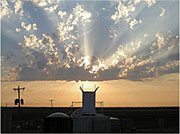- Number 360 |
- April 9, 2012
Clouds get in the way

Clouds get in the way.
Using 10 years of data gathered at three unique Atmospheric Radiation Measurement sites, scientists at DOE’s Pacific Northwest National Laboratory and Lawrence Livermore National Laboratory found that global climate models are not representing just how much clouds mask the sun's warming energy. And for the first time, scientists used data on the spatial coverage, height, and transparency of the clouds to inform climate models. They found the relative monthly and annual differences among three cloud fraction datasets at each site are small. However, comparing observations with a dozen global models used in the fourth Intergovernmental Panel on Climate Change assessment report shows that cloud coverage is significantly misrepresented in the models, by up to 150 percent at one site.
The sun's energy, or solar radiation, is the primary source of Earth's warming. But clouds get in the way, changing the amount of energy reaching the Earth's surface. Scientists want to know just how much energy is reaching the surface and how much is reflected away or absorbed by clouds. Getting an accurate measurement of clouds, or how much surface they shade at any one time, will help scientists predict how and where clouds influence Earth's warming and cooling. Beyond warmth and cooling, getting an accurate picture of cloud cover will impact predictions of precipitation and air quality around the world.
"Everyone agrees that clouds are the most uncertain agent for prediction in climate models. That's why the U.S. Department of Energy has made a substantial investment in collecting cloud and radiation observational data," said Dr. Yun Qian, atmospheric scientist at PNNL and principal investigator on the study. "In our study, we have taken the raw data and showed how it's ultimately valuable for evaluating cloud fraction, height, and their radiative effect. We then compared this data with a collection of climate models used in IPCC report to answer the questions, ‘Where should you pay more attention?' and ‘How well do current global models include clouds and cloud fraction?'"
This research was supported by the U.S. Department of Energy's Office of Biological and Environmental Research.
[Kristin Manke, 509.372.6011,
kristin.manke@pnnl.gov]
